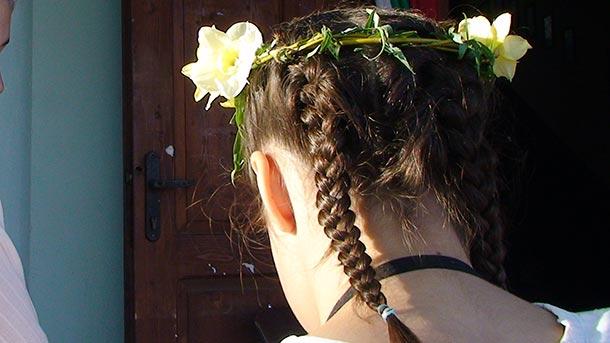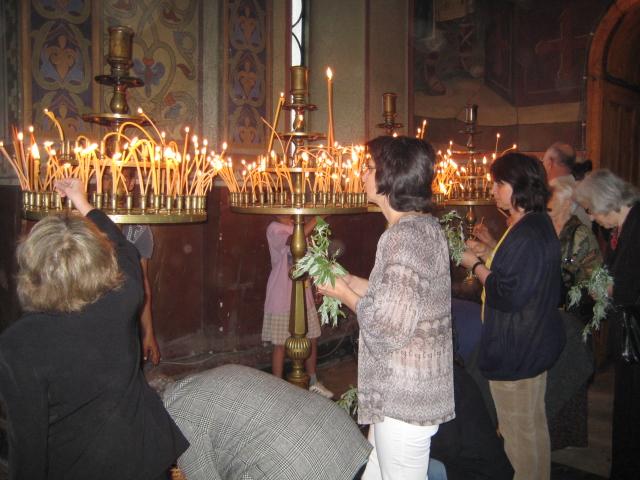 6
6
Though an integral part in the cycle of a few great Christian feasts, the folklore celebrations of Lazaritsa (equivalent of the Feast of Saint Lazarus) and Tsvetnitsa (equivalent of Palm Sunday) are distinctly Bulgarian. They represent a eulogy of resurrected nature, of youth and the hope for a new beginning. They are held with the same degree of optimism today as well though diversified with a range of contemporary inputs. How Lazarki girls dress, what is laid on the table… We revisit the tradition and make sure that we are surrounded with greenness, color and cleanness – in any sense of these words.
Lazaritsa precedes Easter and is held on the Saturday that Orthodox Christians relate to one of the wonders worked by Jesus Christ – the resurrection of Lazarus. The folklore ritual has a much different meaning though its name does refer to Lazarus. In the Bulgarian mythology Lazarus is “the master of woods and leafage”. He has got an axe in his hand and tills people’s fields. This mythical champion of goodness personifying the borderline between earthly existence and the next world is central to the ritual songs and dances of Lazarki girls. Similar to Christmas carol-singers they chant blessings for health and fertility. There are blessings offered to hosts, to girls and lads, to brides and children… Lazarki tour all houses in the village and everywhere their hosts give white eggs and coins to them. Drawing a symbolical circle, the end of the tour finally brings them to the starting point.
On the next day, Tsvetnitsa (Palm Sunday), the ritual of “koumichene” is performed. Young girls gather by the river outside the village where water goes smoothly. They carry the so-called “dolls” – elongated ritual loaves of bread. Small bits of bread are placed on battledores which girls let go floating on the water. The girl whose bit of bread wins the race will marry first. In traditional beliefs, a girl who has been a Lazarka girl and has gone through the ritual of “koumichene”shall not be taken away by a dragon. In the past it was impossible for girls to marry had they not been part of the Lazaritsa tradition, simply because the dragon would come to abduct them after they had become brides. Initiation was mandatory to go through, and only after that the girl would be allowed to wear a wreath and flowers in her head; dress in embroidered shirts, wear jewels such as a necklace, earrings, rings and bracelets.
 Willow Day is the other name of the traditional feast of Tsvetnitsa. With willow twigs Christians and Catholics have replaced palm branches involved in the welcome of Jesus Christ in Jerusalem a week before His crucifixion. The willow has bivalent symbolism in the Bulgarian tradition and its branches are blessed in church on Palm Sunday to bring health and to protect the family. Today too, we attach willow twigs to icons and doors, and churches are crowded on Tsvetnitsa. Some choose to go to church only on that great day. Priests store hundreds of willow twigs and give them out, blessing the faithful. If you choose to make a trip to the Bulgarian countryside on Tsvetnitsa, you will for sure come across Lazarki girls somewhere. Clad in colorful folk costumes, the teenage girls tour the houses of the community. Well, it could be that one or two of them might wear snickers under their embroidered shirts and shirts might be larger than their size. Well, at least all of them readily sing and dance in street processions. Do not miss the chance of giving them a small gift. This act is believed to bring health and good luck to you.
Willow Day is the other name of the traditional feast of Tsvetnitsa. With willow twigs Christians and Catholics have replaced palm branches involved in the welcome of Jesus Christ in Jerusalem a week before His crucifixion. The willow has bivalent symbolism in the Bulgarian tradition and its branches are blessed in church on Palm Sunday to bring health and to protect the family. Today too, we attach willow twigs to icons and doors, and churches are crowded on Tsvetnitsa. Some choose to go to church only on that great day. Priests store hundreds of willow twigs and give them out, blessing the faithful. If you choose to make a trip to the Bulgarian countryside on Tsvetnitsa, you will for sure come across Lazarki girls somewhere. Clad in colorful folk costumes, the teenage girls tour the houses of the community. Well, it could be that one or two of them might wear snickers under their embroidered shirts and shirts might be larger than their size. Well, at least all of them readily sing and dance in street processions. Do not miss the chance of giving them a small gift. This act is believed to bring health and good luck to you.
Every year, the chitalishte (community culture club) in the village of Kralevo not far from Targovishte, re-enacts Bulgarian traditions and rituals, organizing contests such as “Master lyutenitsa - maker” and “From granny’s dresser”. And for the..
According to popular belief, the color red has the power of the sun and gives vitality to every living being, while white symbolizes purity, innocence and joy . The appearance of the twisted white and red threads, known as martenitsa, means that winter..
The Philip Koutev National School of Folk Arts is not just any school - it is a talent laboratory. It is the first school not only in Bulgaria but in the Balkans for professional study of folklore. It is located in the heart of the beautiful town of..

+359 2 9336 661
